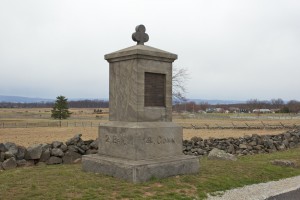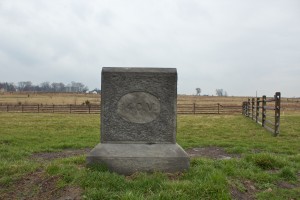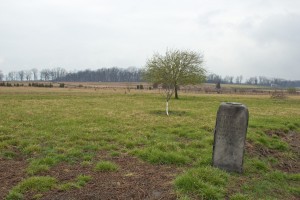 The service of the 14th Regiment, Connecticut Volunteer Infantry, at Gettysburg is honored with several monuments on the battlefield.
The service of the 14th Regiment, Connecticut Volunteer Infantry, at Gettysburg is honored with several monuments on the battlefield.
The most prominent of the monuments honoring the regiment stands on Hancock Avenue, not far from the Angle, and marks the position from which the 14th helped repel Pickett’s Charge on the climactic third day of the battle.
The front (east) face of the monument, dedicated in 1884, features a bronze plaque describing the regiment’s Civil War service and major battles, including Antietam, Fredericksburg, Chancellorsville, Gettysburg, and several others before Appomattox.
The monument’s east face bears the simple inscription, “14 Conn.,” and the monument is topped with the Second Corps’ trefoil emblem.
The monument’s north face indicates the regiment’s affiliation in the Third Division, and the south face lists the division’s Second Brigade.
The west face of the monument features a plaque with a detailed description of the 14th’s actions during the battle of Gettysburg. The plaque reads, “The 14th C.V. reached the vicinity of Gettysburg at evening July 1st, 1863, and held this position July 2nd, 3rd and 4th.
“The regiment took part in the repulse of Longstreet’s grand charge on the 3rd, capturing in their immediate front more than 200 prisoners and five battle flags. They also, on the 3rd, captured from the enemy sharpshooters the Bliss buildings in their far front, and held them until ordered to burn them. Men in action, 160. Killed and wounded, 62.”
 Bliss Barn
Bliss Barn
As the Hancock Avenue monument indicates, the 14th was involved in heavy fighting to capture the William Bliss farm buildings from Confederate sharpshooters harassing the Union line.
The Bliss barn stood about four-tenths of a mile west of the 14th’s position on Cemetery Ridge, in the no-man’s land between the Army of the Potomac and the main Confederate line on Seminary Ridge.
The barn and the nearby house changed hands between Union and Confederate forces several times on July 2. The 12th New Jersey and 1st Delaware had been able to capture the farm, but its exposed position and vulnerability to skirmish and artillery attacks made holding it very difficult.
 On the morning of July 3, the 12th N.J. recaptured the barn, but was forced to withdraw. The 14th Connecticut was sent back to the farm, but soon found themselves outnumbered and under attack again.
On the morning of July 3, the 12th N.J. recaptured the barn, but was forced to withdraw. The 14th Connecticut was sent back to the farm, but soon found themselves outnumbered and under attack again.
To resolve the struggle for the Bliss buildings, orders were sent to the 14th CT to burn the barn and house. After doing so, the 14th withdrew to the Union line along Cemetery Ridge.
The 14th’s contributions to the capture and destruction of the Bliss farm are marked with several monuments at the site. The former center of the barn is marked with a granite monument bearing, on its east face, the 2nd Corps trefoil and a brief summary of the burning of the Bliss buildings.
 The west face of the monument, which stands in front of a mound that led to the barn’s second story, is inscribed “14 C.V.”
The west face of the monument, which stands in front of a mound that led to the barn’s second story, is inscribed “14 C.V.”
A short walk to the north, a smaller marker indicates the center of the Bliss house. The monument also explains the house was captured and burned by the 14th on July 3.
A monument to the 12th New Jersey stands between the two Connecticut monuments, and a monument honoring the 1st Delaware stands north of the former house site.
An acre surrounding the former barn and house was purchased by surviving members of the 14th Regiment in 1885, and that purchase is marked by four small boundary markers (similar to the battlefield’s flank markers) that remain on the site today.
 The regiment, recruited primarily from central CT, mustered into service August 23, 1862, with 1,015 men. Less than three weeks later, the barely trained regiment found itself in intense fighting at Antietam’s Bloody Lane. During the war, the regiment fought in 34 engagements between Antietam and Robert E. Lee’s 1865 surrender at Appomattox.
The regiment, recruited primarily from central CT, mustered into service August 23, 1862, with 1,015 men. Less than three weeks later, the barely trained regiment found itself in intense fighting at Antietam’s Bloody Lane. During the war, the regiment fought in 34 engagements between Antietam and Robert E. Lee’s 1865 surrender at Appomattox.
Tags: Gettysburg








